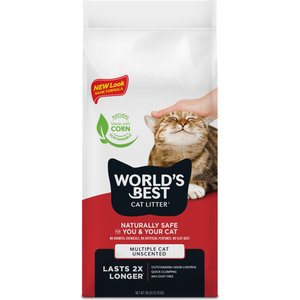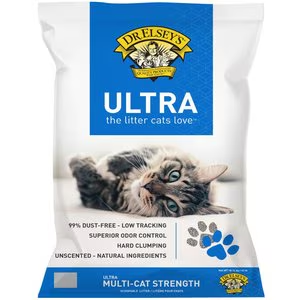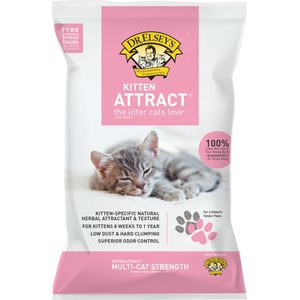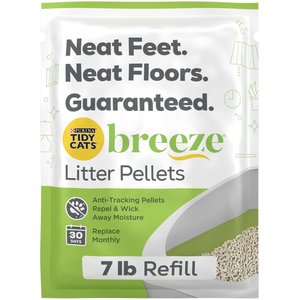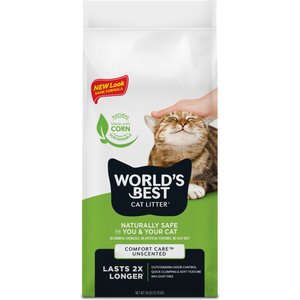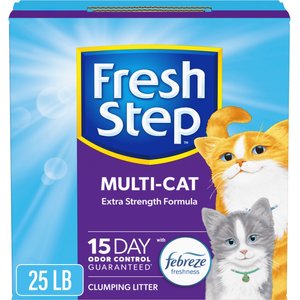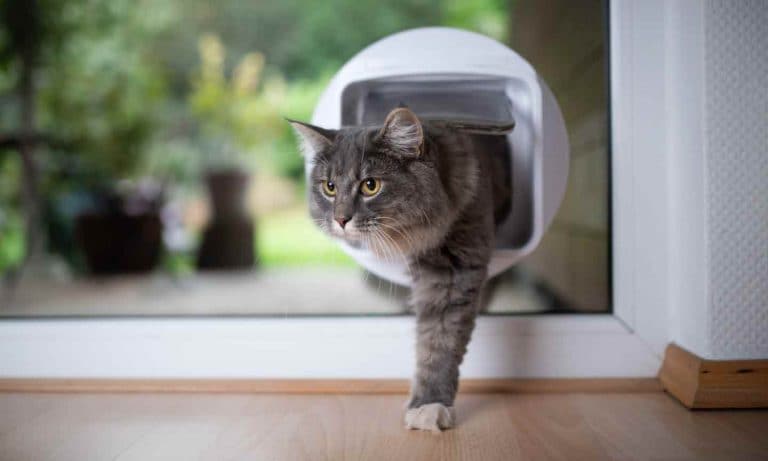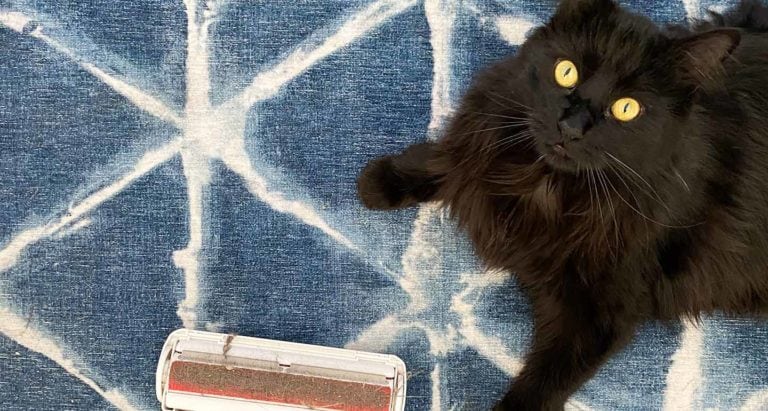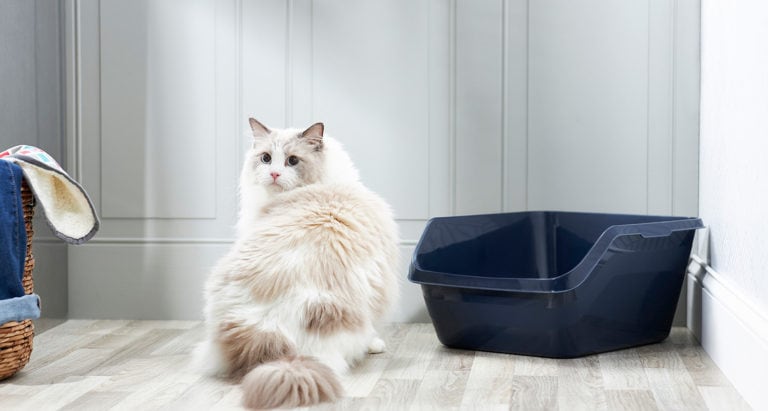As every cat parent knows, cleaning the litter box is one of the least rewarding aspects of the job. However, the right cat litter for your and your pet’s needs can make all the difference.
There are a wide range of litters available today, each offering unique benefits to cats and cat parents. Which one you choose can impact how easy it is to keep your space clean, your home smelling fresh and your cat happy.
Bathroom business is serious business, so there’s quite a bit to consider before selecting a litter. Read on for everything you need to know about the best cat litter on the market today, including expert tips and product picks from pet parents like you.
-
1
Best Cat Litter OverallWorld's Best Multi-Cat Unscented Clumping Corn Cat Litter, 28-lb bag $35 on Chewy
-
2
Best Cat Litter for Odor ControlFresh Step Premium Crystals Scented Non-Clumping Crystal Cat Litter, 8-lb bag $21 on Chewy
-
3
Best Clumping Cat LitterDr. Elsey's Ultra Multi-Cat Clumping Clay Cat Litter, 40-lb bag $21 on Chewy
-
4
Best Dust-Free Cat LitterArm & Hammer Slide Multi-Cat Clumping Clay Cat Litter, 38-lb box $27 on Chewy
-
5
Best Flushable Cat LittersWheat Scoop Multi-Cat Natural Clumping Wheat Cat Litter, 14-lb bag $17 on Chewy
How to Find the Best Cat Litter
At first glance, the amount of cat litters available today can be overwhelming. Where to start? First, consider these important factors:
- Materials: Cat litter is made from a variety of materials—from clay to silica gel to corn—with each offering its own benefits and drawbacks (more on that below).
- Clumping vs. non-clumping: To clump or not to clump, that is the age-old question. While there is no correct answer here, many cats (and cat parents) have strong preferences.
- Your litter box: If you have an automatic litter box, it’s important to use the type of litter suggested by the manufacturer. Many automatic litter boxes can use standard clumping litters, while others require specific litters.
- Your number of pets: If multiple cats will be using the litter, you might consider a multi-cat formula, which has additional odor neutralizers.
- Your cat’s health: If your cat has certain health conditions, your veterinarian may advise you to use specific litters. For example, cats with respiratory issues may benefit from low-dust litters. Some even change color to indicate potential health problems.
- Your lifestyle: Are you able to transport a heavy clay litter, or do you need a more lightweight option? Is non-tracking litter (litter that doesn’t stick to your cat and travel out of the box with them) important to you? How sensitive are you to fragrance or lack of fragrance? While your cat’s preferences are important, your litter also needs to work for your household.
- Your disposable method: How do you plan to dispose of litter? If you plan to scoop and flush, it’s important to use a flushable variety that’s safe for your plumbing.
- Your veterinarian’s advice: Using the litter box is an important part of your cat’s day, so consult your veterinarian before making changes to your litter, and ask for trusted product recommendations.
10 Best Cat Litters
To help you choose, we’ve rounded up the best cat litters as tested and approved by Chewy customers. These top-selling, top-rated cat litter brands get two paws up from cat parents like you.
Best Cat Litter Overall
-
Little if any odor
Wow, this litter is so awesome. No odor if you change it out once a week at a minimum and little if any tracking.
-
Quick clumping, less smell, no dust!
Just like the title says! For these three reasons I have used World’s Best Litter for my cat for years. Heads up: the corn flake ingredient apparently makes the litter tastey to any nosey pups, so keep an eye on that!
-
Dustless cat litter
This is truly the world’s best cat litter for my cat. No more clouds of dust settling everywhere and most of all not being inhaled by my cat. My sister insisted that I try this litter and I’m so glad I did. Liquids clump firmly for easy cleaning. My cat accepted the new litter readily
Best Cat Litter for Odor Control
-
So much better than clay!
I started using Fresh Step crystals when I first adopted my cat and I like it better than standard clay litter. The amount of dust that it produces is much more tolerable than clay litter, it doesn't hover around in the air as long. It still does what every other litter does, it tracks a bit but I think that comes with the territory regardless of the brand and type of litter. I never realised how much clay litter REEKS until I smelled it at a friend's house. I will never use clay again (I did with the cats I had in the past), and I hope the price won't skyrocket so I can continue to use this brand. I've gotten it for nearly 5 years now,...
-
I LOVE CHEWY!
Ordering with Chewy was so easy. I found exactly what I was looking for, and in less than 2 minutes, my transaction was concluded. Two days later, my items were on my front porch. I Love Chewy!
-
Less dust lasts longer
This litter is by far the best around. I’ve tried othered and always come back to this crystal non scented litter. Just simply scoop the poo and stir the crystals. You’re certain to save with the ladybug litter. My cats love it too. Not a lot of tracking.
Best Clumping Cat Litter
-
Have used for many years
Even though there are many new litters out there this brand has always been my go to. Dust? All clumping litter has dust but this has less according to friends so will continue to order.
-
Low Dust, Clumps Well
Reasonable cost cat litter that clumps well and has low dust compared to a 'house' brand that I used to buy at a warehouse store. I like that it is unscented. Perfumes just mask the odors that tell you it is time to clean the litter box.
-
Picky cat
The only litter my cat will use! I've tried other brands and he just won't. He's spoiled to say the least.
Best Dust-Free Cat Litter
-
Convenience!
So much easier getting this delivered to my door than driving to the store and lugging around heavy boxes of cat litter. Plus it’s less expensive!
-
Almost dust free
Wonderful litter. A bit pricey, but with multiple cats in my house, it clumps well, almost dust free and my cats like it.
-
Very little dust
This is my new favorite cat litter. It clumps well and doesn’t stick to litter box. There’s very little dust and it absorbs most of the smell
Best Flushable Cat Litter
-
Works well
I used to use synthetic litter but for the past ten years I’ve used this natural one. It clumps well if you wait ten or fifteen minutes. It is a little more dusty so scoop slowly and try not to shake much. But over all I like this bestter because I feel it is safer for my cats health.
-
Timeliness and accuracy
I am amazed how quickly my orders show up at my house and how convenient it is. Unfortunately I recently had to put one of my cats down so I will not be ordering as frequently. Once when the cat food cans were so badly dented, Chewy made good by replacing them.
-
Great but expensive
This is the litter our breeder uses & recommended for our Maine Coons - this mixed with Dr. Elsey's Cat Attract litter (also recommended by breeder) seems to control order better than litters we have used in the past with our previous babies.
Best Litter for Kittens
-
Excellent clumping.
Overall probably the best litter I’ve tried. Excellent clumping and odor control. I just wish it were cheaper and lighter.
-
Dr. Elsey’s kitten litter
I mix about 1/4-1/3 with Dr. Elsey’s regular litter and my adult male seems to like it a little more than just te regular litter.
-
Amazing Litter!
Not sure if it's 100% the litter but this made it very easy for us to litter train our new kittens. They were attracted to the litter and it made it an easy process. This litter did not seem scented to us and did cover the box odors fairly well. It clumps nicely and was easy to lift and use. I have repurchased a few times now.
Best Non-Tracking Cat Litter
-
Best Litter Box for My Cat
We started off with regular cat litter when we got our cat and it didn't work very well for him. He often got wet litter 'mud' all stuck between his little paws. And the litter would get tracked all over the house. This system is so neat and so clean. It really helped my cat and me too!
-
Convenient size
Whether adding to my existing kitty litter or changing the box totally, this product is light enough for me to not be inconvenienced by lifting heavy bags.
-
No tracking litter!
This litter is not meant to absorb the urine. My cat pees right through the pellets and the pad underneath absorbs it. The poop sits on top and is scooped out. Once in a while I see a pellet on the floor but no more litter grains everywhere! The only thing that is a bit annoying is how loud the pellets scrape against the plastic when Blossom covers her poo. Her litter box is in the room next to my bedroom and I wake up to her covering her poo. Imagine pellets in a plastic container and shaking it for about a minute or so. Otherwise best non tracking litter ever!
Best Natural Cat Litter
-
Best litter
World’s Best is excellent cat litter. I have been using one of the different variations for years. Trying this version for a kitten whose paws are more sensitive to the feel of the litter.
-
Great product
I have used this product for years, it works very well. It creates clumps and makes cleaning out the litter an easy process.
-
The absolute best,
I’ve been lurching kitty litter for years. This is truly, honestly the best. Just as advertised! Your nose and family will thank you!
Best for Multiple Cat Households
-
Serves its purpose
I assume that this product is good because my cats pee & poop in the litterbox with this litter in it. Granted, it's the only litterbox available to them. However, I feel like if this litter was not good, my cats would poop & pee in my closet or something.
-
Fresh step litter
This is the best litter in my opinion for litter as far as odor control and clumps quickly. Doesn’t leave spots on my carpet like the others I’ve used in the past.
-
I really like this litter!
I love that you offer the smaller bags. I have a hard time lifting the 20-25lb boxes. These bags just make life so much easier for me.
Best Budget Cat Litter
-
Best litter ever!
Love this litter and thew cat does too! He is a Ragdoll, 16+ pounds and drinks his weight in water daily (or so it seems) I have to clean the box twice a day (he is not diabetic) just thirsty. The litter is the best I've ever used with many decades of cats.
-
No Dust!
I am so happy. I wish I had bought the larger size because the difference in tracking, dust, and fragrance is unbelievable! It is hard to find a true fragrance-free litter, but Frisco has done it. Also, low tracking is generally a joke. My next purchase will be the largest size!
-
Best litter ever!
We have been using this litter for a few years, and it's really great! It doesn't track all over, there's never any odor, and the pee balls are very sturdy, don't break up.
Types of Cat Litter
Cat litters are available in a wide range of materials and offer a number of features. Here, Joey Lusvardi, CCBC, a Minneapolis-based certified cat behavior consultant and founder of Class Act Cats, helps us break it down.
Clay
The most common types of cat litters are made from clay—specifically bentonite clay, which is highly absorbent, although other types of clay may be present depending on the type of litter. Clay litters can be clumping or non-clumping, and with a consistency reminiscent of sand or dirt, offer an alluring, natural texture.
“For most cats, a basic unscented clay clumping litter will work great, as it is easy to scoop; controls odor well if you scoop regularly; and it meets the preferences of most cats,” says Lusvardi.
Best for: most cats without special litter needs; budget-conscious pet parents
Silica Gel
Also known as crystal litter, silica gel litter is a mineral-based litter made from silica gel granules. The lightweight granules trap odors and absorb urine without clumping, and produce minimal dust. Some brands, such as PrettyLitter, change colors to help monitor the cat’s urine content.
While many cats happily use crystal litter, others may not like the texture. “Crystal litter tends to have sharp edges, and may not be very comfortable for cats to walk on,” Lusvardi says.
Best for: pet parents who prefer a lighter litter; cats with respiratory and urinary health concerns; households concerned about litter dust and tracking
Natural
Natural cat litters are made from sustainable, biodegradable materials including paper, corn, tofu, cedar, walnuts and grass. Natural litters rely on their fiber-heavy compositions to absorb urine.
Because natural cat litter is made with renewable materials, it’s one of the most eco-friendly options you can choose, says Lusvardi. “I often recommend clients try a grass litter if they are thinking of switching to a natural litter. It has qualities that are pretty close to a typical clay litter but is less dusty.”
Best for: ingredient-conscious and environmentally friendly pet parents; cats who do not like the texture of more traditional litters; cats who are sensitive to chemicals and fragrances
Multi-Cat
Multi-cat litters typically contain extra odor neutralizers and fragrances, making them effective at keeping households with multiple pets smelling fresh. Multi-cat litters can be made from a variety of materials, and many cats tolerate them. However, if your cat is sensitive to fragrance, these litters may not be appropriate.
“If your cat has a sensitivity, try to find as boring a litter as possible,” says Lusvardi. “Unscented litters are going to have fewer chemicals than scented litters.”
Best for: households with multiple cats; pet parents concerned about odors
Flushable
Flushable litter is made with 100% biodegradable ingredients, meaning that—unlike clay or silica litters—clumps and soiled portions can be flushed down the toilet. Not every toilet or septic tank can effectively manage flushable litter, though, so it’s important to research your system before selecting a litter.
Best for: pet parents who don’t want solid waste in the trash can
Clumping
Clumping cat litter is a popular variety of clay litter that is extra absorbent, causing the clay to form firm clumps when it comes into contact with liquid. A clumping formula makes it easy to scoop out urine, meaning the box smells fresher and has to be emptied less frequently.
While most pet parents who purchase clay litter would prefer the clumping variety, non-clumping can be better for some cats. “For long-haired or even some medium-haired cats, clumping litter may get stuck in their fur,” Lusvardi says. “This is incredibly uncomfortable, so they may prefer a non-clumping litter that won’t try to tag along after they use the litter box.”
Best for: pet parents who want to easily scoop and conserve litter; short-haired cats
Low-Tracking
While no litter is 100% non-tracking, low-tracking varieties are typically made from larger, heavier granules that are more likely to stay in the box instead of clinging to kitty’s feet or fur. Low-tracking litters are great for keeping the house tidy, but not all cats enjoy the texture.
Best for: pet parents concerned about stray litter
How to Litter Train a Cat or Kitten
Litter-training a cat or kitten doesn’t have to stink! Follow these easy steps for bathroom success:
- Choose the right equipment. Set your cat up for success with a shallow box that’s easy to get into, as well as a kitten-friendly litter, such as Dr. Elsey’s Kitten Attract Clumping Clay Cat Litter.
- Place the box in a safe space. Cats like privacy and easy access, so put the litter box in a low-traffic area that’s effortless to find.
- Show your cat the boxes. Almost immediately after bringing a new cat or kitten home, show them the litter box. As they get acclimated to their new home, continue to place them in the box a few times a day.
- Scoop the box daily for feces and urine. Cleaning litter boxes isn’t a glamorous chore, but it’s an important one. A dirty litter box is stressful to cats, and many will refuse to use it.
- Be patient. Your new pet may have a few accidents, and that’s OK. Never scold your cat; instead, calmly and thoroughly clean up the mess to avoid your cat going in the same place again.
For more litter-training tips, check out our comprehensive Chewtorial guide.
Cat Litter Troubleshooting
Sometimes, a perfectly trained cat will stop using the litter box. Some common reasons include:
- The box is different. Cats don’t like change. If you recently bought a new box, moved the box or switched to a new litter, your cat might not be comfortable with the new arrangement. If you must change your cat’s bathroom setup, try to make the changes subtle and gradual.
- The litter is dirty. Many cats won’t use a dirty box, even if it contains the greatest cat litter on the planet. Scoop your litter at least once a day, and replace it at least once a week.
- The box is too small. Your cat should be able to comfortably turn around in the litter box. If it’s the same box you purchased when your cat was a kitten, it might be time to buy something bigger.
- You have a kitty bully. In multi-cat households, one cat might “claim” the litter box. Make sure you have separate boxes for each cat, and place them in separate parts of the house.
- Stress. Cats can sense household stress, so a change in the family dynamic (such as a new baby or home renovations) can cause litter box issues. Try to stick to daily routines, and consult your veterinarian about ways to reduce your pet’s stress.
- Underlying medical issues. If your cat is sick, they may have trouble using the litter box. Always contact your veterinarian about any abrupt changes to litter box habits.
For more troubleshooting tips, check out our handy guide on solving cat litter problems.
How We Chose These Products
The right kitty litter can make all the difference for both cats and cat parents. That’s why we rounded up these top-selling, top-rated products, as chosen by satisfied Chewy customers. Backed by thousands of ratings and stellar cat litter reviews, these best-in-class litters are kitty-tested and pet-parent approved.
Talk to Your Veterinarian
The litter box is an important part of your cat’s routine and health, so before making changes, discuss them with your veterinarian. They can make suggestions about the best litter for your cat.
It’s also important to consult your veterinarian if you notice changes to your cat’s litter box habits, including accidents outside the box or straining to go. “The occasional lapse in litter-box usage may not be cause for concern, but recurrent or abrupt issues require immediate veterinary attention,” says Dr. Bethany Hsia, DVM, a Clovis, California-based veterinarian and co-founder of CodaPet.
Cat Litter FAQs
Q: What is the least messy cat litter?
A: The least messy cat litters are clumping, low-tracking litters made from heavier granules, which are less likely to stick to a cat’s feet or fur. If dust is a concern, silica litters are virtually dust-free.
Q: How often should you change cat litter?
A: Cats prefer clean boxes, so plan to scoop your box at least once a day (and twice when possible). Once a week, empty the litter pan completely; clean it with unscented dish soap; and refill with new litter.
Q: Why did my cat stop using the litter box?
A: Cats may stop using the litter box for a variety of reasons, including a change to the litter box, litter or location; dirty litter; an uncomfortably small box; intimidation from another cat; stress; or an underlying health issue. If you notice a change in your cat’s litter box habits, consult your veterinarian.
Cat Litter: Next Steps
Cats bring immeasurable joy, comfort and companionship to our lives, enriching every corner of our homes—except, perhaps, the litter box corner. Fortunately, we’ve come a long way since messy, one-size-fits-all litters.
Next order of business? Finding the perfect litter box for your feline friend. Read our guide on everything you need to know about buying litter boxes, from the latest high-tech options to tried-and-true favorites.
Expert input provided by Dr. Bethany Hsia, DVM, a Clovis, California-based veterinarian and co-founder of CodaPet, and Joey Lusvardi, CCBC, a Minneapolis-based certified cat behavior consultant and founder of Class Act Cats.
Learn more about cat bathroom behavior:
Share:

